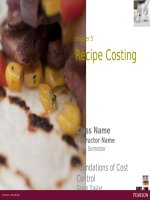Foundations of cost control by daniel traster chapter02
Bạn đang xem bản rút gọn của tài liệu. Xem và tải ngay bản đầy đủ của tài liệu tại đây (1.46 MB, 42 trang )
chapter 2
Basic Math
Class Name
Instructor Name
Date, Semester
Foundations of Cost Control
Daniel Traster
Rounding
•
Provides ease of writing numbers
•
Reduces accuracy
•
Too much rounding or rounding repeatedly at each step in a process
can greatly impact the final result in a recipe or costing exercise.
2
Rounding Terminology
4.87315
The 8 is in the tenths place
The 7 is in the hundredths place
The 3 is in the thousandths place
3
How to Round
•
Identify the place to which to round (the target place)
•
If the number to the right of the target is below 5, drop all digits right of the
target
•
If the number to the right of the target is 5 or higher, increase the target by 1
and then drop all digits to the right of the target
•
When rounding up, if the target is a 9, you will have to “carry the one” as in
addition.
4
Example 2a
Round 71.8972 to the nearest hundredth.
“9” is in the hundredths place
“2” is to the right of it
Round down to 71.89
5
Example 2b
Round 71.897 to the nearest hundredth.
“9” is in the hundredths place
“7” is to the right of it
Round up to 71.90
6
When to Round and By How Much
•
In multi-step calculations, only round in the final step
•
How much depends on the measurement tools available
•
How accurately can the following tools measure?
―digital scale
―beam scale
―volume measures
•
Money is only relevant to the nearest penny
7
Example 2c
An adjusted recipe calls for 16.34 ounces of flour measured on a digital scale.
Round appropriately
The scale only measures to one-tenth of an oz
Round to 16.3 oz
8
Example 2d
Round $23.469 appropriately.
Money rounds to the nearest penny
The answer is $23.47
9
Numerators and Denominators
Identify numerators and denominators.
Which are less than “1”?
Which are greater than “1”?
Which are equal to “1”?
Note: computers often format as 4/9
10
Mixed Numbers
2¾
The “2” is the whole number
The “¾” is the fraction
11
Converting a Mixed Number to a Fraction
1. Multiply the whole number times the denominator
2. Add the result from step 1 to the numerator
3. Place the result from step 2 over the original denominator
12
Example 2e
Convert 4 2/3 to a fraction.
1. Multiply the whole number times the denominator
4 (whole) x 3 (dem.) = 12
2. Add the result from step 1 to the numerator
12 + 2 (num.) = 14
3. Place the result from step 2 over the original denominator
13
Converting a Fraction to a Mixed Number
1.
Divide numerator ÷ denominator
2. Result is whole number and remainder
3. Write whole number and place remainder over original denominator
Example 2f
Convert 9/4 to a mixed number.
1. Divide numerator ÷ denominator
9÷ 4 = 2 remainder 1
2. Write whole number and place remainder over original denominator
2¼
15
Converting to a Mixed Number Using a Calculator
1.
Divide numerator ÷ denominator
2. Subtract the whole number
3. Multiply decimal by original denominator (to get the “remainder”)
4. Write whole number followed by remainder over the denominator
16
Example 2g
Write 27/8 as a mixed number using calculator.
27 ÷ 8 = 3.375
Subtract whole number to get 0.375
Multiply 0.375 X 8 (denominator) = 3
Answer is 3
3
/8
17
Multiplying by Fractions
1.
Multiply the numerators
2. Multiply the denominators
3. Place the multiplied numerators over the multiplied denominators
18
Example 2h
X
=
Multiply 3 X 4 = 12
Multiply 8 X 3 = 24
Answer is
12
/24
19
Dividing Fractions
1.
Invert the second fraction (flip it upside-down)
2. Multiply the two fractions
20
Example 2i
÷
=
Invert 2nd fraction and multiply:
X
=
=
21
Reducing Fractions
1.
Dividing numerator and denominator by the same number does not impact
the fraction’s value, only its appearance
2. It is as if you are dividing or multiplying by 1
3. The only challenge is finding a number that divides into both numerator and
denominator
22
Example 2j
Reduce 12/24 to simpler terms.
12 and 24 are both divisible by 12
=
23
Converting Fractions to Decimals
Using a calculator, simply enter:
Numerator ÷ Denominator
24
Example 2k
Convert 4/9 to a decimal.
Enter 4 ÷ 9 into a calculator to get 0.4444…
Answer is 0.444 (rounded)
25









